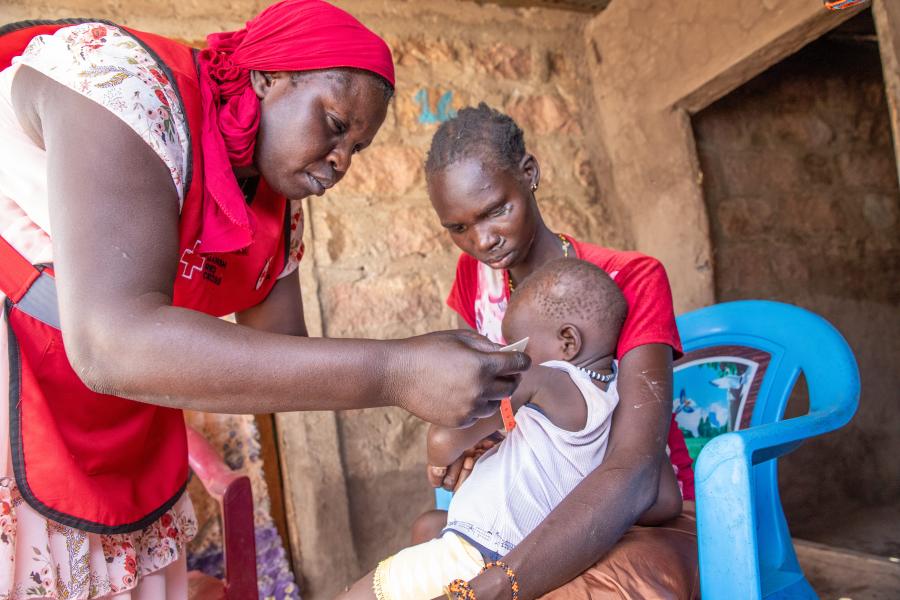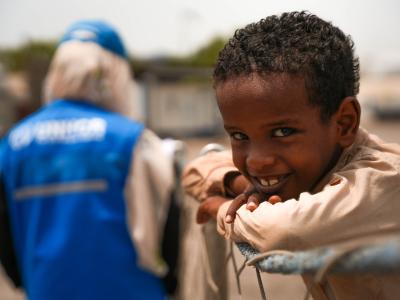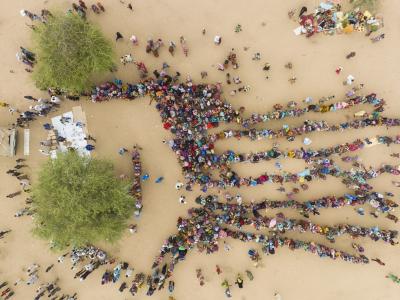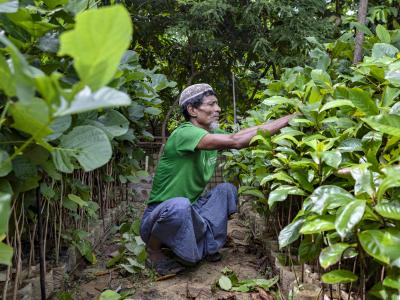Results in 2023
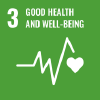
People who have been forced to flee or who are stateless are among the most vulnerable groups in the world. Their physical and mental health is at risk due to the dangers and stresses that they experience, and yet they often face obstacles in getting care because of their legal and economic situation. In 2023, UNHCR worked with governments and partners to provide emergency health services, strengthen local health services and include refugees in national health systems and plans.
Overall, the health situation for refugees remained relatively stable in 2023 although there was an increase in outbreaks reported, mostly in Africa, and challenges remained in reaching childhood vaccination targets and in delivering adequate services in new emergencies such as in Sudan.
Over 14 million people benefited from UNHCR-supported health services in 2023, compared to 12 million in 2022. In the 19 countries using the UNHCR integrated Refugee Health Information System, the average crude mortality rate was stable at 0.09 deaths/1,000/month. The under-five mortality rate (U5MR) declined to 0.16 deaths/1,000/month compared to 0.24 in 2022. However, in Sudan the U5MR exceeded thresholds (> 2 deaths/10,000/day) due to malnutrition and measles outbreaks. The main causes of deaths globally were malaria (20%), neonatal conditions (7%), lower respiratory tract infections (6%), cardiovascular diseases (5%) and anaemia (4%).
Increasing the uptake of skilled delivery at birth is fundamental to improving maternal and neonatal health. The skilled birth attendance rate remained stable at 93%. 69% of reporting countries met the target of 90%, a small increase from 68% in 2022. Actions to improve maternal and child health were supported through facility- and community-based interventions, including 11,494 community health workers (54% women, 46% men) funded, equipped, and trained with the support of UNHCR.
Despite improvements in some countries, childhood vaccination coverage remained below target. Only 29% of countries achieved more than 95% measles coverage. In the Democratic Republic of the Congo (DRC), UNHCR supported measles and polio catch-up campaigns that achieved coverage of over 95%. In Bangladesh, community health workers increased the proportion of stateless Rohingya children vaccinated with a second dose of measles vaccine from 36% to 71%, but further action is needed.
Increased disease outbreaks have been reported due to low vaccination coverage and the impacts of climate change. Results from the public health annual survey show that 76% of country operations reported at least one outbreak, compared to 63% in 2022, and there were 21 measles outbreaks reported, compared to 14 in 2022. UNHCR and partners responded to outbreaks of measles, cholera, malaria, dengue, polio and Hepatitis E in 2023.
Data from the Standardized Expanded Nutrition Surveys from 116 refugee settlements in 18 countries showed that only 50% of the settlements met the global acute malnutrition (GAM) standard of <10%. 28% had a GAM prevalence 10-15% (serious) and 22% were above the emergency threshold of ≥15% (critical). The Sudan crisis led to a dramatic situation with SAM admissions increasing eightfold and 1 in 3 children arriving in neighbouring countries malnourished. The crisis also led to high mental health needs among displaced populations. Mental health and psychosocial support (MHPSS) capacity was thus strengthened, including in Chad, through surge support. Through inter-agency collaboration, the Minimum Service Package for MHPSS was introduced to Pakistan and Ethiopia.
UNHCR’s biannual public health inclusion survey in 50 countries indicated that of 49 countries with national health plans and policies, 80% included refugees in those plans and policies. Refugees had access to national primary health care facilities in all surveyed countries, and in 92% of countries, their access was subject to the same conditions as nationals. 49 of the 50 countries reported that refugees could access national secondary and tertiary care facilities, and in 44 countries they had equal access with nationals. 64% of countries had a social health insurance scheme, with 47% of those including refugees.
UNHCR continued collaboration with UNICEF, WFP, WHO, FAO and others to reduce childhood wasting. Five priority actions linked to the Global Action Plan on child wasting commenced in 15 highly affected countries which host over 4.6 million refugees. Outcomes included therapeutic and supplementary feeding for approximately 230,000 malnourished children.
UNHCR, WFP and UNAIDS co-led multistakeholder action to reactivate the Inter-Agency Task team for HIV in humanitarian emergencies. In the DRC this led to joint efforts to strengthen evidence and advocacy for improving HIV programming.
UNHCR and WHO co-convened the Group of Friends of Health for Refugees and Host Communities comprising governments, international organizations, and civil society. The Group announced two multi-stakeholder pledges on health inclusion and MHPSS at the Global Refugee Forum (GRF), backed by over 230 pledges that are expected to drive progress in strengthening national health systems.
UNHCR and Queen Margaret University commenced a three-year study on factors enabling inclusion in health systems. Furthermore, a group of 10 academic partners developed a Global Refugee Forum pledge to extend their expertise to refugee health through research, advocacy, and educational initiatives, including scholarships for refugees. The UNHCR-World Bank Joint Data Center supported Malawi to include refugees in the national demographic and health survey (DHS), an important means to assess the health status and needs of refugees.
In Mauritania, the World Bank and UNHCR facilitated integrating refugees into the national health system, a transition from NGO-run services to the Ministry of Health. In Chad, the World Bank supported the national health system to respond to the influx of Sudanese refugees, providing support for additional staff, ambulances, and medicines.
UNHCR collaborated with the ILO on assessing the feasibility of including refugees in national social health protection systems in Egypt, Ethiopia, and Kenya.
UNHCR’s partnership with the World Diabetes Foundation significantly improved noncommunicable disease care for refugees and host communities in Burundi, Sudan, and the United Republic of Tanzania through capacity-building of staff and health system strengthening.
Multisectoral monitoring results

Essential healthcare services
14.6 million people received essential healthcare services (77 reporting countries)
2022 result: 12 million people (85 reporting countries)

Sexual and reproductive health services*
1.5 million women and girls received sexual and reproductive health services (51 reporting countries)*
2022 result: 994,000 women and girls (57 reporting countries)
*Sexual and reproductive health services include antenatal care, assisted delivery, postnatal care, family planning services and health services for survivors of gender-based violence.

Mental health and psychosocial support
1.3 million people received mental health and psychosocial support services (99 reporting countries)
2022 result: 1.1 million people (82 reporting countries)

Nutrition
191,000 children 6-59 months were admitted for treatment of moderate acute malnutrition (MAM) (33 reporting countries)
2022 result: 140,000 people (37 reporting countries)
95,000 children 6-59 months were admitted for treatment of severe acute malnutrition (SAM) in 34 reporting countries
2022 result: 72,500children in 37 countries
Core indicators

10.1 Proportion of children aged 9 months to five years who have received measles vaccination (%)
29% of reporting countries achieved a target of > 95% measles vaccine coverage in children aged 9 month – 5 years.
2022 result: 30% of countries

10.2. Proportion of births attended by skilled health personnel (%)
69% of reporting countries achieved the target of > 90% births attended by skilled health personnel.
2022 result: 68% of countries
Trends in response
Challenges to achieving outcomes
Underfunding severely constrained efforts to ensure access to comprehensive essential preventive and curative care, leading to suboptimal vaccination coverage and reduced support for national health systems in the face of new emergencies, worsening effects of climate change, outbreaks, and greater needs. This included limited provision of medicines and resources for referrals for hospital care. In countries like Sudan, insecurity severely hindered access to those in need.
Progress towards greater inclusion in national health and social health protection systems is often hindered by inadequate financial support to low- and middle-income countries. Some progress has been made through development partnerships, but sustained financing is crucial for meaningful progress.
Financial overview
Global expenditure and budget for Healthy lives
$299 million spent against a budget of $578 million
$279 million of unmet needs or 48% of the budget
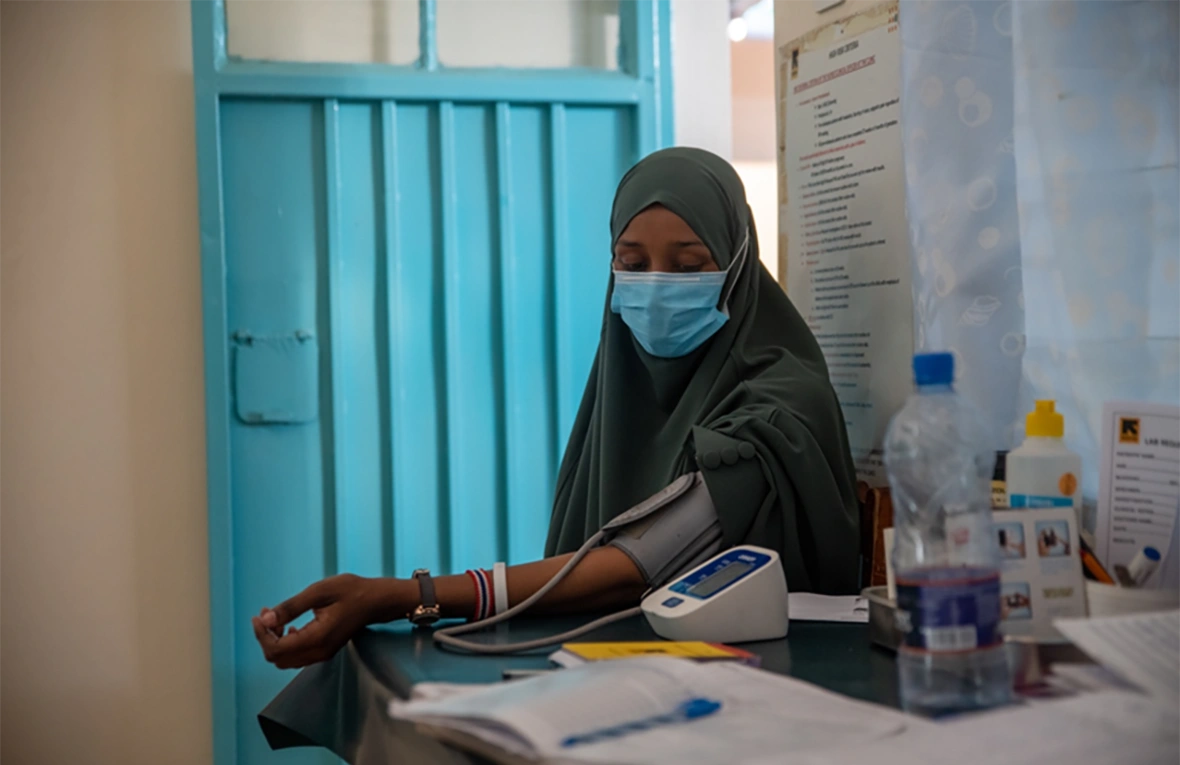

Novo Nordisk and Grundfos Foundations support inclusive health in Kenya
The Novo Nordisk Foundation and the Grundfos Foundation pledged $9 million in 2023 to help develop a more inclusive and sustainable health system in Kenya’s Turkana County, where the Kakuma refugee camp and Kalobeyei settlement are set to be integrated into the national health system. The partnership will improve healthcare staffing, set up dedicated clinics for non-communicable diseases integrated into primary health facilities, and ensure these facilities have access to sustainable water and sanitation services.
Refugees and host communities will benefit from better quality health services and will enjoy better health as a result. The collaboration is part of the new Inclusive Refugee Response Partnership led by the Ministry of Foreign Affairs of Denmark.
